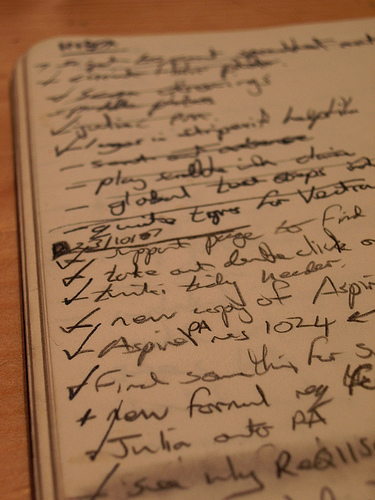
This morning I got out of bed with the realization that I often have to sort out the same set of e-mails twice: once on my desktop and once on my laptop. Realizing that this was getting in the way of me keeping on top of e-mail as it comes in, I found myself a good Web-based interface for my e-mail, where I started by working on just my last ten days of e-mail. I went through every single non-spam message I had received in that time, sorting them into appropriate folders, responding to or following up on the ones that could be done within a minute or two, and putting about half a dozen that will require more time into a special “REPLY/ACT” folder where I’ll be able to easily tackle them in order. Then I went over the past month and a half and any marked e-mails in my own inbox and added anything that stood out to the REPLY/ACT folder.
And now my inbox is empty. This doesn’t mean that I have no e-mails to respond to, but that I’ve cleared away everything except the e-mails that will need detailed responses and have those easily accessible in priority order. As new e-mails come in, I’ll deal with them in a similar way, since I have a system in place and am going to the same spot to handle e-mail whether at home or on the road. Instead of always opening my e-mail box to a long list of mostly-unimportant e-mails, I’ll open it to a few things that I’ll review, fire off quick replies where those are needed, and have a single place where the bigger tasks will go. Everything else will get filed away. This takes very little time, now that my system is set up. And since I had been gradually developing my ideas of how to sort e-mail in past attempts at this process, it all came together quickly, in just over an hour!
Update, March 30th: I’ve continued emptying my inbox this way virtually every day since I started the process, and it has continued to be much easier than my old process. My REPLY/ACT folder sometimes gets more full and sometimes less, but “full” in this case is at most 16 items. The system seems to be working, and I’m definitely much more responsive than I have been in the past, in large part because I get the short responses out of the way immediately regardless of how important they are and have the e-mails that need longer responses somewhere they’re easy to find and pick off.
What Stress Has to Do With Organization
We can mostly only do one thing at a time, so ideally we’d always know exactly what that one thing should be at any time. Let’s say you’re at home, no phones are ringing, and nothing’s on fire. What do you choose to do with your time? Relax and watch a movie? Wash the plate and glass on the counter? Go over your kid’s homework? Fix that squeaky door? Catch up on some reading for work? Call your old friend from college you’ve been wanting to get back in touch with? Organize papers for tax season? Every responsibility–like housekeeping, friendships, bills, work, concerns about world hunger–and every way we communicate–like mail, notes sent home from school with kids, email, voice mail, conversations with family members–provides another potential source of things that might need to be done. And it’s exactly the same in a work or school environment, often with a completely separate set of systems in each location.
The problem is that all of these inputs can be stress-producing, if not overwhelming. Without some serious organization, it’s next to impossible to keep track of all of them at once, which means that anything that isn’t getting taken care of can potentially be a distraction and a worry. You find yourself regularly pushed around by thoughts like “Do I really have everything set up for the trip next week?” or “I keep thinking I need to pick something up at the hardware store” or “I’ve got to remember to get back to that prospect with a quote.”
Fortunately it is possible to channel some of this chaos and cut back on stress. Here are a few quick tips to that end, inspired in part by my continued reading of Dave Allen’s excellent organizational book, Getting Things Done, along with other sources.
Recognize your inputs. Anything that’s not in the place where you want it to be, may need to be acted on, needs to be reviewed to decide whether you need to act on it, is in the way of you knowing or doing something you need to know or do, etc. is an input, a potential “to do.” That doesn’t mean that you need to waste attention to all of those things every time you notice them, only that they’ll tend to dilute your focus unless you’ve got some kind of reliable system in place to handle them.
Don’t let the noisy things distract you from the important things. An e-mail about a new version of some software you use may be interesting and may pop up right in front of your face while an important financial matter that doesn’t have a specific deadline could be lingering in the background. It can help to have places to put lower-priority things as they come in, for instance an “Interesting/check out” folder in your e-mail program for that e-mail to go until after the financial matter is settled.
Minimize the number of task systems you use. Almost everyone needs more than one task list: for instance, you might have an e-mail program with messages that need to be read, responded to, or acted on; plus a traditional “to do” list, a place to stack incoming mail, etc. But it’s easy to let task systems proliferate–a few notes written on paper here, an occasionally-updated PDA task list there, a stack of unreviewed papers on your desk to go through, etc.–making it difficult or impossible to determine what the one thing you want to do at any given time is, because there are too many places to look to figure that out.
Ditch unimportant tasks. Still have last week’s newspaper because you didn’t get around to reading it but might still? Consider how often you’ve gotten around to ever reading a week-old newspaper before, and if it’s close to 0% of the time, the newspaper can go. I’ve found sometimes in the past that I’ve been hanging onto an unimportant tasks for years–something that really would be good to do, but has never been important enough to trump all the other things that are going on in my life on a daily basis. It can be freeing (and a good way to cut down on an unrealistically long task list) to be able to look at some items like this and say “I’m just going to decide to not do that one.”
Part of how you’ll be happiest dealing with all of these inputs will depend on whether you want to organize your life or just keep the noise level down a bit. You may find you want the productivity and peace of mind you can get from a real organizational system. Allen’s book is a good resource for tackling this if you decide to.
On the other hand, maybe your life isn’t all that hectic, but a little additional clarity and order will help–in which case the suggestions above might be enough to give you the lift you’re looking for.
If you’re not sure whether it’s worth committing to a big organizational effort, ask yourself: Am I sometimes not taking care of things I need to get done, with bad consequences? Do I feel overwhelmed or anxious about the things I need to do? If either of these is a yes, time spent organizing effectively can provide relief while making more efficient use of your time. A successful organizing effort pays for the time it takes to do it in short order, and doesn’t have to necessarily be done all at once to be effective.
Photo by andres.thor
Like this:
Like Loading...











 In previous articles, I gave a
In previous articles, I gave a 